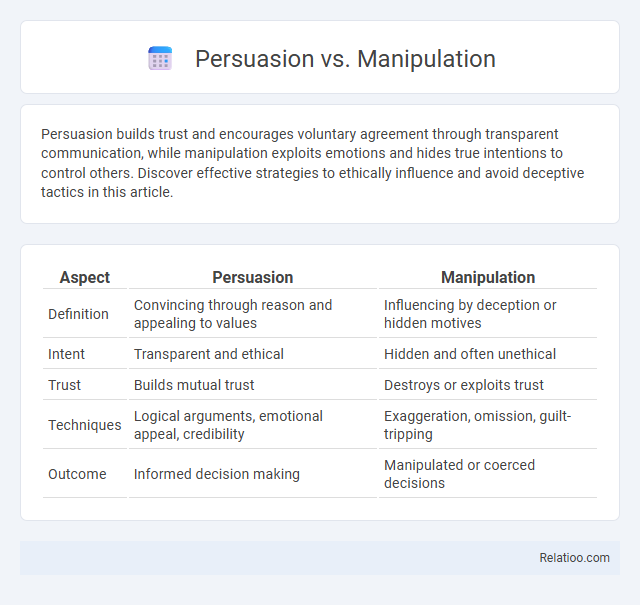Persuasion builds trust and encourages voluntary agreement through transparent communication, while manipulation exploits emotions and hides true intentions to control others. Discover effective strategies to ethically influence and avoid deceptive tactics in this article.
Table of Comparison
| Aspect | Persuasion | Manipulation |
|---|---|---|
| Definition | Convincing through reason and appealing to values | Influencing by deception or hidden motives |
| Intent | Transparent and ethical | Hidden and often unethical |
| Trust | Builds mutual trust | Destroys or exploits trust |
| Techniques | Logical arguments, emotional appeal, credibility | Exaggeration, omission, guilt-tripping |
| Outcome | Informed decision making | Manipulated or coerced decisions |
Understanding Persuasion and Manipulation
Understanding persuasion involves ethically guiding others to adopt your ideas through clear communication and genuine reasoning, whereas manipulation relies on deceptive tactics that exploit emotions or misinformation for personal gain. Persuasion respects the autonomy of your audience, fostering trust and long-term relationships, while manipulation undermines this trust by prioritizing control over consent. Recognizing these distinctions helps you maintain integrity while effectively motivating positive action.
Key Differences Between Persuasion and Manipulation
Persuasion relies on transparency, ethical communication, and mutual benefit to encourage voluntary acceptance of ideas, while manipulation involves deceptive tactics, withholding information, and exploiting vulnerabilities to achieve hidden agendas. Persuasion respects the autonomy and informed consent of the audience, whereas manipulation bypasses logical judgment by appealing to emotions or misinformation. Understanding these distinctions is crucial for maintaining trust and integrity in personal and professional interactions.
The Psychology Behind Persuasion
The psychology behind persuasion involves understanding cognitive biases, emotional triggers, and social proof to ethically guide decision-making and behavior change. Persuasion leverages principles like reciprocity, consistency, and authority to build trust and encourage voluntary compliance without coercion. Unlike manipulation, which exploits vulnerabilities for personal gain, effective persuasion respects autonomy and fosters mutual benefit in communication.
How Manipulation Works: Tactics and Techniques
Manipulation works by exploiting psychological tactics such as guilt-tripping, playing on fears, and using misleading information to control decisions without Your full awareness. Techniques often include selective omission, emotional appeals, and creating dependency to weaken rational judgment. Understanding these strategies helps You recognize when influence crosses ethical boundaries into manipulation.
Ethical Considerations in Influence
Ethical considerations in influence focus on transparency, respect for autonomy, and honesty, ensuring Your ability to persuade others does not exploit vulnerabilities or deceive. Persuasion ethically aims to present logical arguments and emotional appeals without coercion, maintaining mutual respect and trust. Unlike manipulation, which uses deceit or pressure to control outcomes, ethical influence fosters informed decision-making that honors individual free will.
Recognizing Signs of Manipulation
Recognizing signs of manipulation involves identifying tactics such as guilt-tripping, excessive flattery, and intentional misinformation designed to control your decisions for someone else's benefit. Unlike persuasion and influence, which rely on transparent communication and respect for your autonomy, manipulation often exploits emotional vulnerabilities and creates confusion. Being aware of these aggressive strategies helps you maintain control over your choices and protects your mental well-being.
The Role of Intent in Persuasion and Manipulation
Persuasion involves guiding others toward a decision with honest intent to benefit them, while manipulation uses deceitful tactics to serve the persuader's hidden agenda. The role of intent is crucial, as persuasion respects your autonomy and choices, contrasting with manipulation's intent to control or exploit. Understanding this distinction helps you recognize and respond appropriately to ethical versus unethical influence attempts.
Practical Examples: Persuasion vs Manipulation
Persuasion involves presenting clear, truthful information to encourage your audience to make informed decisions, such as a salesperson highlighting product benefits to genuinely meet customer needs. Manipulation, however, exploits emotions or misinformation to deceive, like pressuring someone into buying through false scarcity claims. Your ability to distinguish these tactics ensures ethical communication and builds long-term trust.
Building Trust Through Persuasive Communication
Building trust through persuasive communication requires clarity, honesty, and empathy to ensure your intentions are transparent and respectful. Unlike manipulation, which exploits emotions for personal gain, persuasion centers on fostering mutual understanding and aligning interests ethically. Influence is the natural outcome when your persuasive efforts consistently demonstrate reliability and genuine concern for others' needs.
Protecting Yourself from Manipulative Behaviors
Understanding the key differences between persuasion, manipulation, and influence is crucial for self-protection against manipulative behaviors. Persuasion relies on honest communication and respects the autonomy of others, while manipulation employs deceit and coercion to benefit the manipulator at the expense of the target. Developing awareness of manipulation tactics such as gaslighting or emotional exploitation and setting clear personal boundaries strengthens one's ability to recognize and resist undue influence effectively.

Infographic: Persuasion vs Manipulation
 relatioo.com
relatioo.com